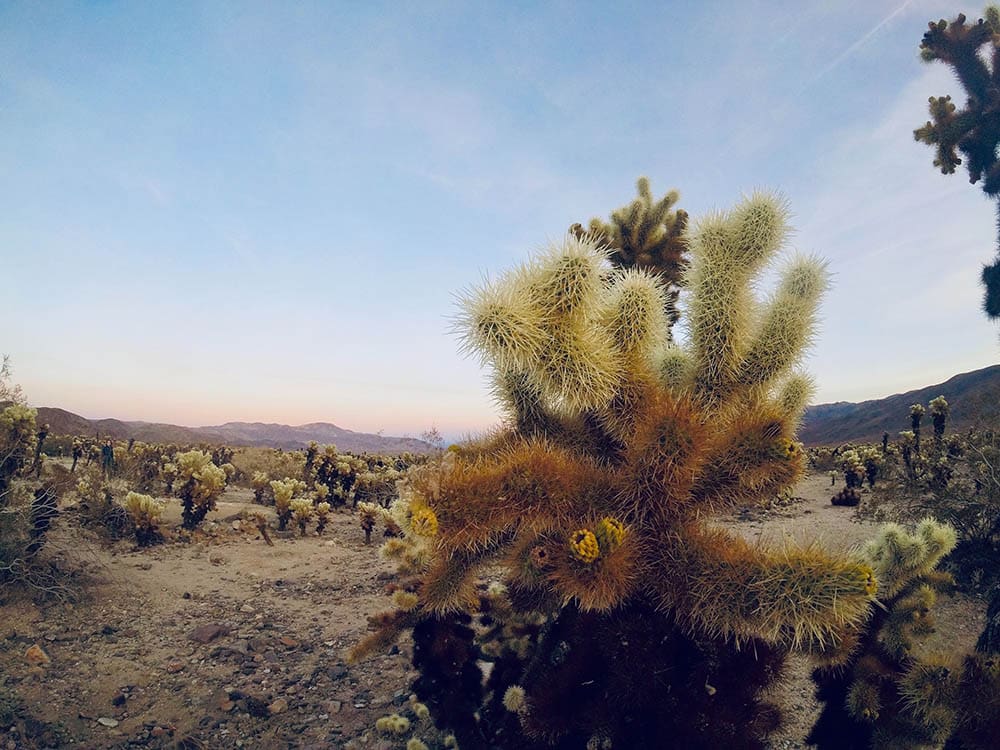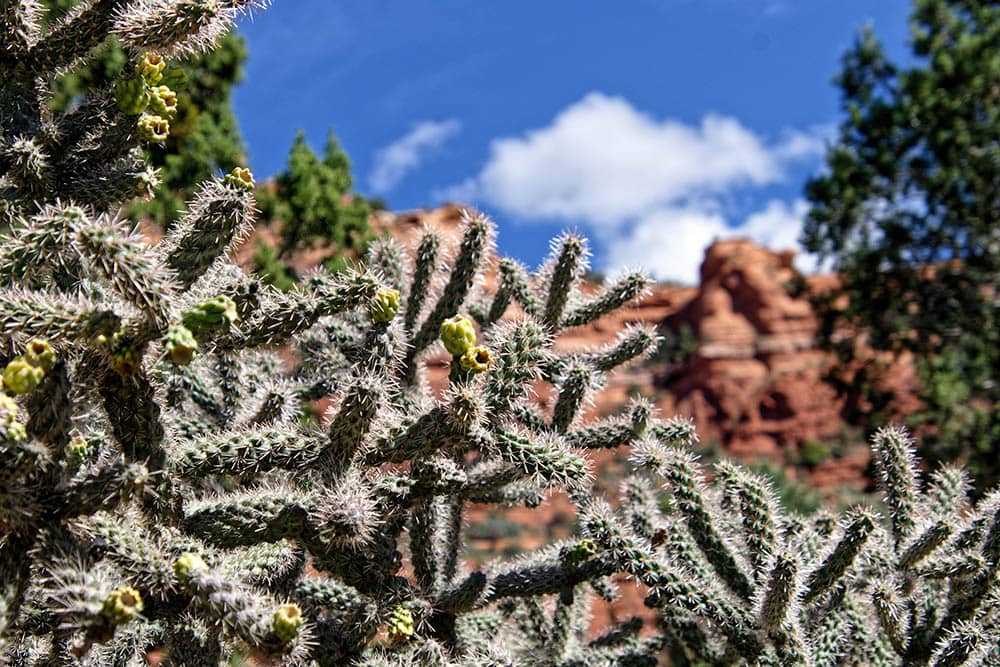5 Types of Cholla Cactus (With Pictures)
-

- Last updated:

Native to North America and West Indies, the Cholla cactus is a family of cylindroid thorny desert plants under the genus Cylindropuntia. There are between 20 and 35 species of Cholla cactus1, which serves as food for desert animals and a source of cooking fuel. Annually, the cactus blossoms and bears fruits, some of which are edible.
The plants vary in size, from shrubby tree-like specimens to dwarf cacti with highly segmented stems. At the beginning of the growing period, segments form new growth and are clearly visible at the joints. Each joint has a tubercle or a raised notch, which is a highly modified leaf base.2
Chollas are one of the most common cacti and are widely used for decoration and gardening. This article will explore some of the unique types of Cholla cactus and their morphological characteristics.
The 5 Types of Cholla Cactus
1. Buckhorn Cholla

Scientifically known as Cylindropuntia acanthocarpa, buckhorn is a species of cholla cactus that is rampant across the Mojave and Sonoran deserts. It can grow to as high as 10 feet in California, where conditions are generally favorable. Towards the east, the plant’s height and branch density drop considerably.
Buckhorn cholla branches out vibrantly and irregularly, making it a not-so-good cacti species for small gardens and indoors. It is impenetrably covered with short brownish spines that protect a yellow or purple green stem. The stem is yellow-green in moist conditions, but as the dry season sets in, it changes to purple green.
To animals the untidy appearance coupled with sharp spines makes the plant unapproachable—this is a natural defense mechanism. It protects nutritious buds and green fruits, which later turn to brown as they mature. The approximately 2-inch wide flowers start forming in early spring or April in some places and put on attractive red-orange and pink hues. The flowers taste like asparagus, and you will find them in many Indian cuisines.
2. Cane Cholla

Native to Arizona, Oklahoma, and some parts of Texas and New Mexico, cane cholla is also known as a “walking stick” or chain-link cholla. It closely resembles buckhorn cholla though its silhouette reflects a uniform tree-like structure.
The stem is thicker, more than an inch wide at the base, and branches at uniform intervals. The branch forms a right angle to the stem and develops as 5 to 20 inches long segments. Due to the weight of the segment, the branch tends to drop down at the end.
Each segment is closely guarded by tubercles and whitish spines. Spines form clusters numbering 10 to 20.
The plant blooms to purple flowers in late April, May, and June. In rare cases, flowers turn pink, and after pollination, they form yellow fruits that are blunt in taste.
Besides animal seed dispersal, cane cholla spreads by breaking off at the joints when disturbed. The segment then sticks to a furred animal and later drops off at another location or forms roots close to the mother plants. Due to various propagation methods, this cholla is often difficult to control.
After several decades, the plant dies and decays in the middle leaving behind a hollow stem used as a cane, suggesting the possible origin of its name.
3. Jumping Cholla

The jumping cholla is a giant tree-like cactus with a low branching trunk that can reach 12 feet high. It mostly grows in Sonora, northeast Mojave, and the Yuma desert. It also grows near the Colorado River at elevations just above 1,000 feet.
Young branches appear in spring and are covered with inch-high bright silver, yellow spines. As the branch matures, spines harden and darken to gray hues and form dense layers that obscure the deep brown backs.
Because most spines fall off with time, old stems are scaly and sparsely protected.
The jumping cholla cactus has attractive pink-white and lavender flowers which blossom in June and July. They are fertilized into sterile and fleshy pearl-like oval fruits. Instead of falling off, the fruit forms a small green branch, and at its tip, next season’s flowers will blossom. After a few years, it forms hanging chains of fruits earning the plant another name, “hanging chain” cholla.
4. Diamond Cholla

Diamond cholla stands out with its short structure up to 6 feet high and neatly growing branches. The plant is averagely the size of a pencil-thick and is well armored with yellow-brown tipped spines. The spine pierces the green-gray bark at right angles.
In some diamond cholla species, spines are absent or grow around the tip of the branch, leaving other parts dressed in a smooth back. Distinctively, joints have diamond-shaped tubercles, which are also thorny.
Yellow flowers form once a year and gradually develop into green fruits. The fruits then turn brown after maturity and will hang on the branches until winter sets in, where the two will separate.
Inhabiting the harshest regions, the diamond cholla cactus is found in the driest part of the Sonoran Desert and lower parts of both sides of the Colorado River.
5. Christmas Cholla Cactus

Aptly named, the Christmas cactus develops stunning red berries around Christmas. However, don’t be fooled by its color. The fruit has intoxicating effects when consumed in large quantities. To avoid that, selected members of the Indian communities would crush and mix it with Apache. The resulting concoction is a potent narcotic drink.
The shrubby Christmas cacti can reach 3 feet high. But when naturally supported by trees, it easily doubles that. Branches are weak and narrow, barely a quarter an inch thick, and are covered by a few spines.
Christmas cactus thrive well in both deserts and grasslands of the USA and northern Mexico and, together with diamond cholla, are a familiar sight in many home gardens. The cholla rapidly grows to colonize an area of roughly 9 square feet in a few months, and if left unchecked, it may spread uncontrollably.
Springtime blooms are bright ranging from white to cream, and mature into red fruits. In nature, birds eat the fruit and disperse the seeds, which will sprout at the onset of rain.
Final Thoughts
Cholla cactus is a beautiful family of desert-growing plants, essential to arid ecosystems and a source of food and fuel. The family has many members, with some towering to 15 feet while others kiss the ground at 3 feet. Irrespective of these differences, cholla cactus blossoms each year, producing bright flowers.
Some flowers mature into edible fruits, while others form a chain of sterile fruits. The plants propagate using seeds or by breaking off branches. Chollas cacti, which combine both seeds and branches, spread out rapidly.
Featured Image Credit: Mark Wieder, Unsplash
Contents

